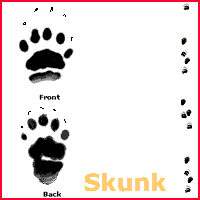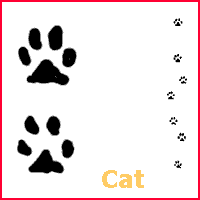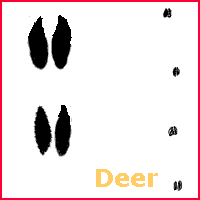NatureNorth's Tracking Guide - Page 3
 |
Mephitidae (Skunks) |
 |
Skunks have 5 toes front and hind, with large central pads, and prominent claws.
Striped Skunk (Mephitis mephitis)
Front = 3 x 2 cm, hind 4 x 2 cm, stride = 10-15 cm (walk: left to right foot). Throughout the province, except the extreme north. |
 |
Felidae (Cats) |
 |
Cats have 4 toes front and hind, with a large triangular central pad. No claw marks are visible. Front and hind feet are similar. Typical gait is a walk or trot where the hind foot is placed in the print from the respective front foot.
Cougar (Felis concolor)
Front and hind = 9 x 9 cm, stride = 50 cm (walk: left to right foot). In southern Manitoba. Rare.
Lynx (Lynx lynx)
Front and hind = 7 x 7 cm, stride = 35 cm (walk: left to right foot). Throughout Manitoba in wooded areas, except the extreme southwest. |
Bobcat (Lynx rufus)
Front and hind = 4.5 x 4.5 cm, stride = 30 cm (walk: left to right foot). Only in southern Manitoba. Range overlaps with Lynx in the southeast.
Domestic cat (Felis domestica)
Front and hind = 2.5 x 2.5 cm, stride = 10 cm (walk: left to right foot). Throughout Manitoba. Doesn't overlap in size with wild cats. |
 |
Cervidae (Deer) |
 |
Members of this family have distinctive cloven hooves. Front and hind feet are similar and a walking gait is most usual. Generally, only the two large toes will leave an impression, but if the animal is running or jumping the dew claws (the vestigial 1st and 4th toes) will leave a mark.
White-Tailed Deer (Odocoileus virginianus)
Front and hind = 7 x 4 cm, stride = 30-40 cm (walk: left to right foot). Throughout the southwestern third of the province. Tracks from a very large deer might be close to in size to those of a young moose or elk, but young of these species would seldom be far from an adult.
|
Moose (Alces alces)
Front and hind = 13 x 7 cm, stride = 60-100 cm (walk: left to right foot). Throughout the province, except in agricultural areas. Moose pick their feet up high as they walk, seldom leaving "foot drag" marks. They are usually solitary.
Elk (Cervus elaphus)
Front and hind = 11 x 6 cm, stride = 50-90 cm (walk: left to right foot). Found in the southwestern third of Manitoba. Tend to drag their feet through the snow as they walk. Usually stay in small herds in the winter.
Caribou (Rangifer tarandus)
Front and hind = 10 x 10 cm, stride = 50-70 cm (walk: left to right foot). Distinct from others in deer family, with splayed, inward curving toes. Dew claw marks usually accompany the toe prints. Throughout the northeastern 2/3's of Manitoba in coniferous forests and tundra. |
Happy Tracking! Return to Makin' Tracks!
You should also check out: Tracks in the Snow in the Classroom!
And some other winter articles: Black Spruce - My Christmas Tree | Goldenrod Gall Fly
|
| You can help NatureNorth produce more great articles with a secure donation through PayPal. Our Google Adsense ads pay our server costs, but that's about it. To learn more follow this link: Support NatureNorth. Thank-you! |
|
|
Return to: Winter Issue | NatureNorth Front page

![]()
